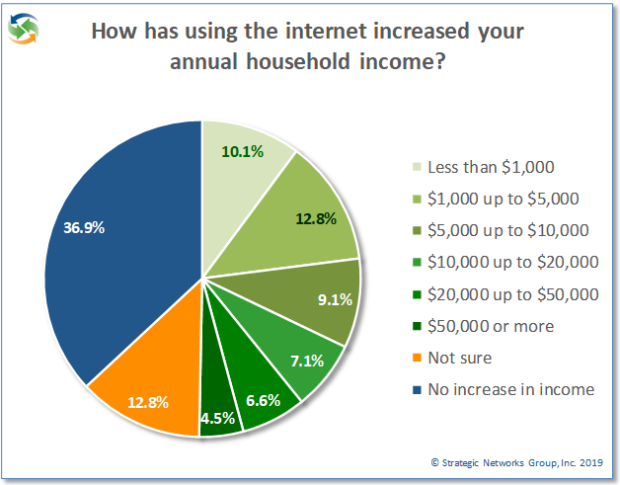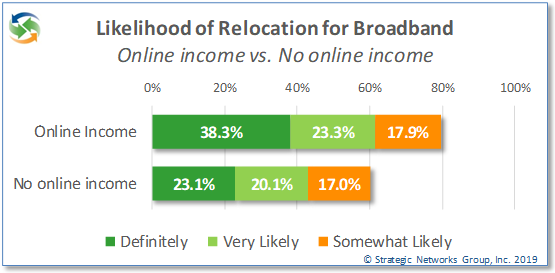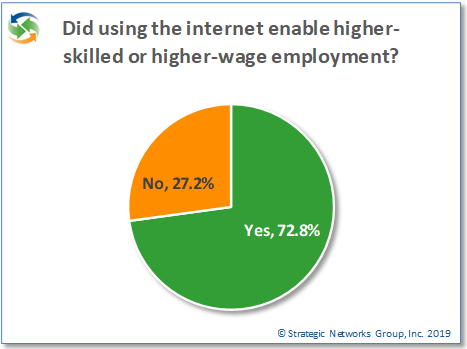 SNG Research Brief – Broadband Impact on Household Income
SNG Research Brief – Broadband Impact on Household Income
Household uses of the internet are often seen as lifestyle enhancements or conveniences, such as online entertainment, social networking, paying bills, or simply browsing for information on topics of inetrest. However, a significant number of households also use the internet to generate income, ranging from small amounts of supplementary income to full time home business income.
More than entertainment and social apps
 SNG’s research of more than 18,000 households shows that 89% have a personal web presence and, while the majority use this for personal or professional networking, more than 30% of these households use their web presence to generate income. Overall, more than 50% of households report that the use of broadband has enabled them to increase their household income in one way or another. 29% earn substantial supplementary income of between $1,000 and $20,000 annually, while another 12% earn more than $20,000 annually. At whatever level of additional income, it can make a huge difference to the lifestyle of most people, and households are finding ways to use the internet and their broadband connections to make it happen.
SNG’s research of more than 18,000 households shows that 89% have a personal web presence and, while the majority use this for personal or professional networking, more than 30% of these households use their web presence to generate income. Overall, more than 50% of households report that the use of broadband has enabled them to increase their household income in one way or another. 29% earn substantial supplementary income of between $1,000 and $20,000 annually, while another 12% earn more than $20,000 annually. At whatever level of additional income, it can make a huge difference to the lifestyle of most people, and households are finding ways to use the internet and their broadband connections to make it happen.
The two most obvious ways that the internet and broadband connections can be used to generate household income are teleworking and home-based businesses. These create income directly from employment and from business activities respectively. However, even excluding these households more than 41% of the remainder still generate additional household income online in amounts large and small.
It is no surprise, then, that more than 50% of households see the ability to work from home as a significant benefit of broadband, and 37% say that the opportunity to earn additional income is a very significant benefit. While there are many other lifestyle benefits from broadband that rate higher across all households, one should not underestimate the significance and impact of how many households use broadband to create household income.
 When you have income generation, access to the internet with quality broadband becomes much more than a “nice to have”. Households see the value in this and community leaders need to recognize this as well. In fact, the likelihood of relocating for quality broadband is significantly higher for those generating income online compared to households that do not. These are innovative households that communities can ill-afford to lose.
When you have income generation, access to the internet with quality broadband becomes much more than a “nice to have”. Households see the value in this and community leaders need to recognize this as well. In fact, the likelihood of relocating for quality broadband is significantly higher for those generating income online compared to households that do not. These are innovative households that communities can ill-afford to lose.
Broadband enhances the workforce
While earning additional household income is significant, the majority of working households still have one or more members employed at jobs, either at an employer establishment or by teleworking. Having access to quality broadband helps households improve their employment in two important ways. First, broadband provides access to online training and education for enhancing skills and learning new ones. Second, with access to a world of opportunities the internet helps people find better jobs, including the ability to telework rather than relocate.
 More than 45% of households use the internet for education or training courses. Of these, 45% strongly agree that online education provides access to more learning opportunities and more than 30% say that online training enabled the completion of a degree or certification. It is significant that broadband can make such a potential difference to the livelihood of one in seven households.
More than 45% of households use the internet for education or training courses. Of these, 45% strongly agree that online education provides access to more learning opportunities and more than 30% say that online training enabled the completion of a degree or certification. It is significant that broadband can make such a potential difference to the livelihood of one in seven households.
Of those households that had a member finding new employment, 73% said that using the internet helped them to gain better employment in higher-skill or higher-wage jobs, with 20% of those households using telework.
Broadband enables people to enhance their skills wherever they live and to find better employment while remaining in their community. These benefits of broadband do not impact every household since not everyone is equally motivated to follow these paths, but broadband makes it possible for those who do.
See what broadband means for a rural county and how they got the support and funding to build the digital infrastructure they need to thrive – Custer County Broadband Impact and Market Assessment.

Find out more about SNG Solutions for Local Economic Development.

“Measuring community the broadband community return on investment”
Research from SNG and others (as well as anecdotal experience) has convinced most decision makers that broadband is beneficial. This, along with federal funding and increased policy focus, is fueling a growing interest in taking this “broadband is beneficial” understanding to the next level of depth and practical value – including assessment of “return on investment.”
Here is how broadband contributes to economic growth – beyond “IT jobs”
The economic spill-over benefits from broadband are more far-reaching, although not as obvious, as the typically narrow “direct impacts” that are typically discussed, such as technology sectors, (e.g. “IT jobs”) and e-commerce activities related to B2C and B2B transactions. To understand the full impact of investing in broadband infrastructure and broadband adoption initiatives one needs to look deeper.
Business users quickly understand the broadband-enabled benefits of doing the same things faster: whatever the organization was doing before such as research, communication, or document transfers, etc. can be done more efficiently and reliably. However, the most significant benefits are generated from opportunities whereby businesses and organizations transform their business operations by using broadband-enabled applications to be creative and do things in new ways that were previously not possible, such as adopting new business models, or reaching-out to new markets.
Although it takes time for most businesses and organizations to determine what broadband-enabled changes makes sense for them and to implement the appropriate “e-solutions”. Enterprises that are motivated – by a need or opportunity – will move quickly to take these transformative steps and the others will follow, which is fundamental to productivity and competitiveness. The same dynamic occurs for organizations that may not be driven by revenues, or profits. All organizations that provide some kind of service have staff, internal processes, and interact with suppliers and clients. Organization growth may not be the first priority, however productivity and service delivery remain important drivers.
The three impact waves
- Direct impacts: The increased revenues and/or cost savings generated from the utilization of broadband and e-solutions. Examples are extending market reach by going online, or reducing long distance charges by using VoIP.
- Indirect impacts: The changes to production, employment, incomes etc. which occur up and down the supply chain from the businesses and organizations generating the direct impacts.
- Induced impacts: The effects of spending wages derived from direct and indirect activities. Households spend their income on goods and services, creating a further ripple effect of economic impact that started with businesses and organizations using broadband.
The net result of the direct impacts from broadband and the spill-over benefits (indirect and induced impacts) increase overall economic activity. Other positive spill-over effects occur, such as demand for new skills and its implications for the labor force. With increasing adoption of e-solutions the need grows for new skills to implement, maintain, and utilize technology and applications to their full benefits. For example, the use of broadband itself also opens up new possibilities for staff training through online resources that would otherwise be unavailable or costly. This important because of the strong linkage between skills development to productivity and innovation.
What impact on the community?
While some of the increased spending created by broadband will occur outside the community, much of it will stay within the community, increasing the overall strength of the local economy through business retention and expansion. Not only does this enable businesses to compete globally on a more level playing field, but also creates a positive business environment to attract new businesses. The creation of new jobs is not only good for those employed, but it also reduces the risk of population decline and can attract high-paying jobs to the community.
Introducing the “community return on investment”
Traditionally, and when left to the private sector, decisions to invest in broadband networks have been based on the typical business case of subscriber revenues generating an ongoing operating profit. We certainly cannot blame service providers for that decision-making criteria – it is their business to make a profit and to choose wisely where to make their investments. Unfortunately, this is also the reason that many communities still do not have sufficient broadband availability – sometimes the business case just does not work for the service provider. When we look beyond the traditional business case and examine the economic impacts from broadband investments we get a very different picture. SNG research has shown that the economic return can be up to 10 times the amount invested in broadband networks. The challenge is how to bridge the gap between the profit-driven decisions of those that build networks and the investments needed to achieve the economic impact potential of broadband.
Increasingly, the answer is coming through public policy interventions at various levels of government, often accompanied by funds to stimulate investment in broadband infrastructure. The underpinning of such public investments needs to be the belief and the confidence that broadband is essential for maintaining business competitiveness and productivity and for enabling economic growth, as well as the numerous social benefits such as enhanced delivery of health and education services. Governments of many countries and regions are taking the leadership to undertake or facilitate investments in broadband in recognition of its economic impact potential – which can actually be measured.
Recent example
Businesses and organizations do increase revenues, reduce costs, and create jobs as a result of using broadband, and they are able to tell us that. For example, in a recent study, we found an 11% average 12-month increase in employment across 221 US organizations directly as a result of using fiber access for their operations. Over 63% of businesses said that their use of fiber was important for increasing sales and 179 establishments generated a total of $3.3M in additional revenue through fiber use. The majority of these impacts occurred in the second and third year after using fiber, reflecting the reality that it takes some time for businesses to integrate new broadband applications into their operations and to see their impact. Such direct impacts create spin-off effects across the rest of the local economy, often at a factor of 2 to 3 times the direct impacts.
Where investments in broadband are made with the goal of stimulating economic activity it is both essential and possible to measure the outcomes from those investments. It is equally essential to invest not only in broadband infrastructure, but also in providing a support and learning infrastructure to assist organizations in effectively adopting and utilizing e-solutions. Combined, broadband infrastructure and skills development generate the direct impacts for their business and the spill-over benefits for their communities. It is only through broad and effective utilization of broadband that economic benefits can be realized.
By Gary Dunmore, SNG
Click here to download this SNG position paper
If you think we can help, or would like to learn more about our broadband sustainable adoption services, please contact us.
 SNG Research Brief – Broadband Impact on Household Income
SNG Research Brief – Broadband Impact on Household Income SNG’s research of more than 18,000 households shows that 89% have a personal web presence and, while the majority use this for personal or professional networking, more than 30% of these households use their web presence to generate income. Overall, more than 50% of households report that the use of broadband has enabled them to increase their household income in one way or another. 29% earn substantial supplementary income of between $1,000 and $20,000 annually, while another 12% earn more than $20,000 annually. At whatever level of additional income, it can make a huge difference to the lifestyle of most people, and households are finding ways to use the internet and their broadband connections to make it happen.
SNG’s research of more than 18,000 households shows that 89% have a personal web presence and, while the majority use this for personal or professional networking, more than 30% of these households use their web presence to generate income. Overall, more than 50% of households report that the use of broadband has enabled them to increase their household income in one way or another. 29% earn substantial supplementary income of between $1,000 and $20,000 annually, while another 12% earn more than $20,000 annually. At whatever level of additional income, it can make a huge difference to the lifestyle of most people, and households are finding ways to use the internet and their broadband connections to make it happen. When you have income generation, access to the internet with quality broadband becomes much more than a “nice to have”. Households see the value in this and community leaders need to recognize this as well. In fact, the likelihood of relocating for quality broadband is significantly higher for those generating income online compared to households that do not. These are innovative households that communities can ill-afford to lose.
When you have income generation, access to the internet with quality broadband becomes much more than a “nice to have”. Households see the value in this and community leaders need to recognize this as well. In fact, the likelihood of relocating for quality broadband is significantly higher for those generating income online compared to households that do not. These are innovative households that communities can ill-afford to lose. More than 45% of households use the internet for education or training courses. Of these, 45% strongly agree that online education provides access to more learning opportunities and more than 30% say that online training enabled the completion of a degree or certification. It is significant that broadband can make such a potential difference to the livelihood of one in seven households.
More than 45% of households use the internet for education or training courses. Of these, 45% strongly agree that online education provides access to more learning opportunities and more than 30% say that online training enabled the completion of a degree or certification. It is significant that broadband can make such a potential difference to the livelihood of one in seven households.




